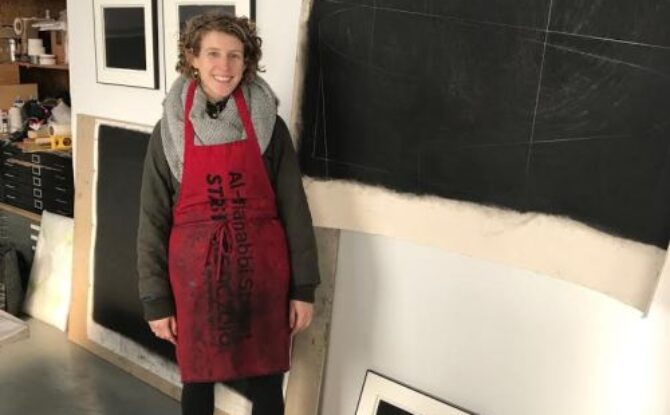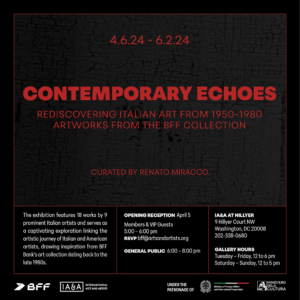
Lines, Folds, Bends, and Matter: Q & A with Anne Smith
Anne Smith is a visual artist and teacher in Washington, DC. Her art practice
spans disciplines of drawing, sculpture and printmaking to study variations on boundaries, paths, and
divisions of space. Her subject matter has included her childhood home, the side of the road, and other
spaces entirely made up or imagined.
Smith is also a teaching artist at the National Gallery of Art in Washington, DC, and has taught drawing at
George Mason University in Fairfax, VA. She has been an assistant to artist Lou Stovall since 2010, where
she has assisted with framing, art installation, silkscreening, writing and a variety of other jobs around the
studio and the DC area.
Your works in To Bend / To Fold focus heavily on the use of black, which seems like a heavy contrast to your more colorful Potomac Prints series. How did you arrive at this mostly monochrome body of work?
For some reason, I have tended to make dense images (that is, with lots of material) for quite a while now. The first drawing I ever did that involved a really dense application of graphite was in 2005, and although the subject matter was very different, it took on this reflective quality with light, setting up a situation in which the image would change depending the viewer’s relationship to it and the light. So, I was hooked then on that interest in light reflection as well as density, and eventually have found myself in the place where I am now—making these charcoal and graphite drawings.
But, I don’t like to work on the same thing for too long! Sometimes I need a break, which is how I might end up making something really light and colorful, like the Potomac Prints series. Even though the bodies of work might look very different, often I find myself circling the same big ideas, just from another perspective.
What is drawing to you? How do you personally define a drawing?
Drawing comes back to the extension of a line. That line has the potential to exist in more than one way – it is first a deposit (or removal) of material on or into a surface, but it can also convince our minds to read more into it, like a line that becomes a road or a house or a shadow. So the line is both the thing itself and (in some cases) the image of a thing.
I think of my linear sculptures and some of my etchings as drawings, too. This has to do with the directness of the processes—working directly into material—as well as the linearity and plasticity/changeability of the materials. Conversely, I often imagine the structures in my drawings as objects, though I would only ever call these drawings. Printmaking can feel downright sculptural, too!
You seem to be inclined to minimalist structures and your works seem to allude to Richard Serra and other modernist heavyweights. Do you consider your work a continuation of the minimalist tradition or is it totally new to you? What other artists or artforms inspire you?
It’s true that in this series of work, I am trying to use as few lines as possible to create a complex structure, but at the same time, I’m doing this with an excess of material (lots of charcoal, or even in the quantity of loose lines that hum in the background of the images). When I’m working, the goal is to follow my own line of curiosity and questioning—if I find myself comparing my work to others’ or thinking too far down the line of how the piece will end up, I know right away that I’m not in the right place for making. What I strive for is to be in a state of making in which I’m trusting my hand and my process and my instincts to lead me to a place I cannot yet imagine.
I do like Richard Serra’s work, and people do make that association sometimes. But I find that I most connect with others whose working values and ways of approaching questions seem like my own, for example Martin Puryear or Janine Antoni. There are also several people locally or from other places I’ve worked and studied who have had huge impact on me. Talking to them is like a breath of fresh air and always resets me whenever I feel lost in the studio.
How do you go about getting ideas? Do you keep a sketchbook? How do you go from idea to final piece?
Ideas come from working! My sketchbook is mostly filled with writing and notes, or with line drawings when I am trying to work out a specific form. I also love taking walks and using my phone to photograph things that pique my interest. When I can, I print these out and tape them into a sketchbook for just this purpose—I like having them in physical form where I can flip through the pages, rather than taking the photo and then never looking at it again. So, walking and looking are forms of work as well.
Of course, there’s no substitute for just working with your materials, encountering problems, and working out solutions. Most of my ideas come not from planning or “brainstorming” but from being there in the moment working on a piece, paying attention as much as possible to where it wants to go. I don’t ever want to fully understand a piece before I’ve finished it (and maybe not for a long time after that). Otherwise, it’s not an interesting idea to me anymore.
You said that sculpture was going to be your next step. How do you see yourself approaching the concept of space with a 3D medium in the future?
I want to spend more time working sculpturally because I’ve always started with the drawing on paper and then moved to sculpture. I want to flip that around, or at least see where it takes me to start by working in three dimensions. In the latest sculpture that I have in the show, Reach, I use plexiglass for the first time and I’ve got a lot more to discover about working with that material. There are other materials that I’ve been attracted to for a while that I haven’t quite gotten myself to engage with physically yet—things like gravel, brick, roofing shingles and other materials more associated with building. I love working with wood, but I’d like to expand my vocabulary and see what happens.

